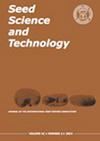蝴蝶兰种子休眠和释放时cga3相关差异蛋白质组学分析
IF 3
4区 农林科学
Q2 AGRONOMY
引用次数: 0
摘要
牧草休眠是一种抵御不利条件的保护机制,包括播种期间出苗率低和不规律。蝴蝶兰是一种高效的C3植物,可作为饲料、燃料、水土保持和水体富营养化指示植物。以前的研究发现,它的种子处于休眠状态,严重影响了它的农业用途。而植物激素赤霉素(GA3)能显著缩短休眠时间。采用双向电泳和质谱法研究了影响黄花蒿种子休眠的ga3相关蛋白。基于绿色植物蛋白NCBI数据库,有30个蛋白在GA3处理后表达显著增加。其中16个上调,14个下调。其中25个蛋白被MALDI-MS-TOF鉴定,20个蛋白被功能鉴定。所鉴定的蛋白质参与糖代谢、蛋白质代谢、RNA合成、脂肪代谢、信号转导、运输、细胞骨架、氧化还原反应和生物合成途径。对禾本科牧草蛋白质组鉴定的4个蛋白进行了关键分析。结果表明,GA3诱导萌发可能与过氧化物酶水平升高有关,通过对苯二酚和醌的可逆氧化还原反应促进葡萄糖6-磷酸氧化,从而促进戊糖磷酸途径,启动休眠停止和萌发。本文章由计算机程序翻译,如有差异,请以英文原文为准。
cGA3-related differential proteomic analysis of Phalaris arundinacea seeds during dormancy and at its release
Herbage dormancy is a protective mechanism against adverse conditions, including low and irregular emergence rates during seeding. Phalaris arundinacea is an efficient C3 plant, which can be used for feed, fuel, water and soil conservation, and as an indicator plant for water eutrophication. Previous studies have found that its seeds are dormant, significantly affecting its agricultural use. However, the phytohormone gibberellic acid (GA3) can significantly shorten the dormancy period. GA3-related proteins that influence seed dormancy in P. arundinacea were investigated with two-dimensional electrophoresis and mass spectrometry. Based on the green plant protein NCBI database, 30 proteins showed significantly increased expression after GA3 treatment. Of these, 16 were up-regulated and 14 down-regulated. Of these, 25 proteins were identified by MALDI-MS-TOF and 20 were functionally identified. The identified proteins were involved in sugar metabolism, protein metabolism, RNA synthesis, fat metabolism, signal transduction, transportation, cytoskeleton, redox reactions and biosynthetic pathways. We carried out a key analysis of four proteins identified based on the Poaceae pasture proteome. The results indicated that germination induced by GA3 may be related to increased levels of peroxidase promoting glucose 6-phosphate oxidation through the reversible redox reaction of hydroquinone and quinone, thereby promoting the pentose phosphate pathway and initiating the cessation of dormancy and the start germination.
求助全文
通过发布文献求助,成功后即可免费获取论文全文。
去求助
来源期刊

Seed Science and Technology
农林科学-农艺学
CiteScore
3.00
自引率
28.60%
发文量
36
审稿时长
>36 weeks
期刊介绍:
Seed Science and Technology (SST) is an international journal featuring original papers and articles on seed quality and physiology related to seed production, harvest, processing, sampling, storage, genetic conservation, habitat regeneration, distribution and testing. A journal that meets the needs of researchers, advisers and all those involved in the improvement and technical control of seed quality. Published every April, August and December.
 求助内容:
求助内容: 应助结果提醒方式:
应助结果提醒方式:


